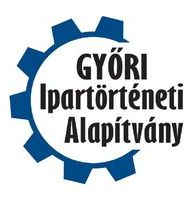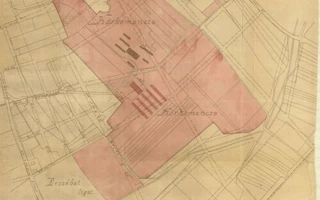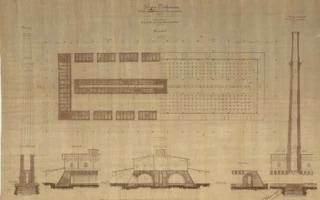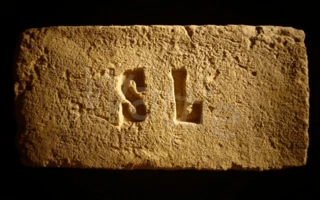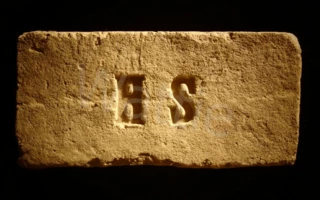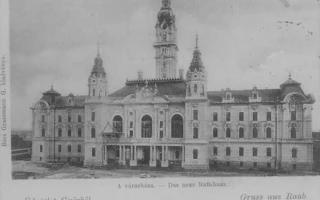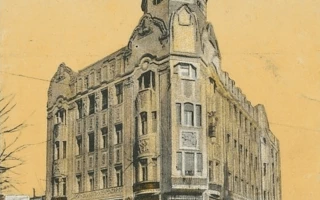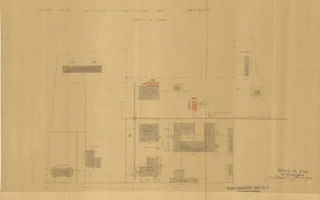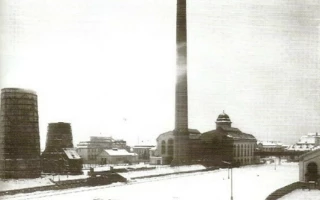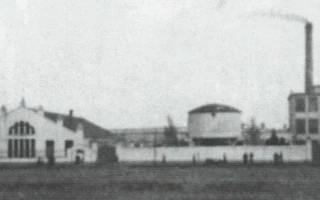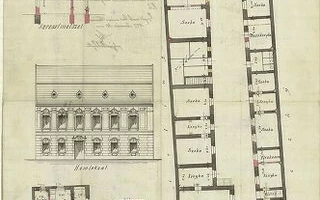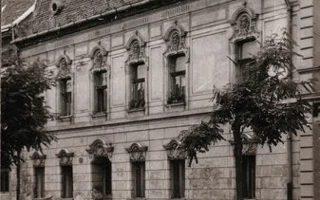Contact details
Foundation for Industrial History of Győr
Szent István út 10/a
Phone:
+3696520274
Fax: +3696520291
E-mail:
ipartortenet@ipartortenet.hu
Map
Schlichter cottage
Lajos Kopcsányi Hlatky-Schlichter (1855 – February 5, 1920) master builder, architect, entrepreneur
He was a well-known and respected member of the contemporary Győr society. He played a leading role in Győr public life for forty years. The citizens of the city elected him a member of parliament in 1908 and 1910. He was the president of the industrial association for several years, and since its establishment, he has been the vice-president of industry and then president of the Chamber of Commerce and Industry.
He also gained national recognition in his profession with the construction of the Cannon Factory.

Lajos Kopcsanyi Hlatky-Schlichter
He was a member of the Győr Legislative Committee for forty years. He was the chairman of the industrial department of the Győr Chamber of Commerce and Industry between October 2, 1890 and November 25, 1913, and then the chairman of the chamber after the death of Antal Jerfy. With the death of Károly Hilbert in 1908, he represented Győr in parliament as one of the city leaders of the Independence 48 Party. During the Soviet Republic, he was held hostage in the building of the Győr State Elementary Teacher Training Institute. His last residence was at Vasutas utca 10.
His wife: Eleonóra Horváth, Mrs. Lóra, (1854 – December 10, 1910) who was the namesake of the famous breed poultry farm (Lóra) once established on Fehérvári Road.
Children: Károly (April 13, 1879 – Écs, July 1954); Gyula (June 20, 1880 – ?); Lajos (November 9, 1885 – Máriakálnok, July 22, 1968)
Parents: Károly Schlichter (1819 - September 5, 1897), Theresa Schmikli (1818 - August 4, 1898)
His father, a bricklayer, educated his son at the universities of Budapest and Munich, where Lajos Schlichter earned a degree in architecture. At the age of 23, in 1876, he took over his father's business and developed the entire vertical of the construction company, from brick production to construction. He soon won orders ahead of local competitors with greater capital. The enterprise, which grew into a large-scale industrial enterprise, operated in the spirit of "quality, reliability and expensiveness".
Lajos Hlatky-Schlichter was also a member of the Győri Körmence Company, which specialized in brick production and had been operating since 1883. The company was transformed into a public limited company on August 12, 1892, with his father, Károly Schlichter.

Site plan of the brick factory for an 1899 architectural plan.
https://maps.hungaricana.hu/hu/GyorTervtar/762/view/?pg=1&bbox=-2090%2C-5796%2C8148%2C36 (download: 2024. 10.1.)

1899. Architectural plan of the brickyard, circular kiln and outbuildings. Builder and designer: Lajos Schlichter
https://maps.hungaricana.hu/hu/GyorTervtar/762/view/?pg=0&bbox=-1180%2C-6772%2C10995%2C164 (download: 2024. 10.1.)
After the company was dissolved in 1896, Hlatky-Schlichter continued to run the company as sole owner. From 1908 onwards, it was known as Hlatky-Schlichter.
The name Körkemence Street still preserves the place of the former brick factory. The monograms on the bricks with the mark refer to the name changes of the owner: GKT Győr Körkemence Társaság; SL: Schlichter Lajos, HSL: Hlatky-Schlichter Lajos.

https://indafoto.hu/wattie/image/25823135-e7aa634d/774027 (download: 2024. 10.1.)

https://indafoto.hu/wattie/image/25823143-2623420d/774027 (download: 2024. 10.1.)
Lajos Schlichter's constantly developing business was greatly helped by his marriage to Eleónóra Horváth, the daughter of one of the city's wealthiest families, as well as his active public and political involvement, and he also performed well in public tenders.
It is no coincidence that he successively won the investment and construction contracts for the most significant buildings in Győr at the time.
We can still admire most of the buildings today.
City Hall
His company, together with his father, began the construction of the Town Hall, designed by Jenő Hübner, in 1892, but due to his father's death in 1897, he was already running the construction company alone when the building was completed in 1900.

City Hall 1898. Postcard.
https://regigyor.hu/belvaros/a-varoshaza/ (download: 2024. 10.2.)
State Secondary School of Réva

https://mandadb.hu/tetel/445115/Allami_Forealiskola (download: 2024. 10.2.)
The foundation stone of the building was laid on August 22, 1892, and the school was ceremonially inaugurated on October 4, 1893.

First savings bank 1912. Postcard.
https://regigyor.hu/belvaros/a-gyori-altalanos-takarekpenztar-szekhaza/ (download: 2024. 10.2.)
Chamber of Commerce and Industry headquarters

https://www.gyoriszalon.hu/news/6843/61/ (download: 2024. 10.2.)
Construction began on August 5, 1903, and was completed in August 1904. All construction work – with the exception of a few special tasks – was awarded to the district's craftsmen.
In addition to public institutions, the complete construction or expansion of several industrial facilities and factories is associated with his business.
Graboplast Factory
Fehérvári Road
Builder: Grab M. Sons Company
Győr architectural plan of leather and wax canvas, 1909. Designer and builder: Lajos Hlatky-Schlichter.

Architectural plan of the Grab factory
https://maps.hungaricana.hu/hu/GyorTervtar/807/view/?pg=0&bbox=-603%2C-4038%2C6636%2C86 (download: 2024. 10.2.)
The creation of the entire Cannon Factory building complex earned the enterprise national fame.

https://ipartortenet.hu/hu/ipartorteneti-emlekhelyek/magyar-agyugyar-rt/#1 (download: 2024. 10.2.)

The Cannon Factory hall and factory buildings
Lajos Hlatky-Schlichter was attacked because his company, as a member of parliament, was able to win the artillery factory contract advantageously. Although the Hlatky-Schlichter and Sons company built the Cannon Factory, the company did not contract with the state, but with the Skoda Works. Lajos Hlatky-Schlichter left the company in 1915.
Construction work on the factory, which spread over 50 acres and consisted of 22 huge buildings (administration building, office, production hall, foundry, forge, warehouse, power plant, laboratory, social room, etc.), began in January 1914 and was completed by the end of 1916.
The company is also responsible for the construction and renovation of numerous residential buildings.
Reconstruction plan of the house at Kossuth Lajos u. 34. 1897.
Builder, designer and contractor: Lajos Schlichter


https://maps.hungaricana.hu/hu/GyorTervtar/321/view/?pg=1&bbox=-1587%2C-2900%2C3531%2C16 (download: October 10, 2024)
From 1901 to 1918, Lajos Hlatky-Schlichter was also on the board of directors of the Győr Workers' Housing Company.
The Hlatky-Schlichter and Sons Public Company was registered on February 25, 1907, and its members were Lajos Hlatky-Schlichter and his son, Károly Hlatky-Schlichter. Then on January 3, 1911, the other son, Lajos Hlatky-Schlichter Jr., joined the company. After Lajos Hlatky-Schlichter Sr. left on November 6, 1915, the two sons continued to run the Hlatky-Schlichter and Sons company until its bankruptcy in 1941.
The Schlichter Villa
In September 1893, Lajos Schlichter applied for and received a building permit to build a one-story residential building based on his own plans in place of his warehouse on Vasútsor. The site's conditions were excellent even at the time of its construction, as it was built in the northern part of Nádorváros, which was then under construction, directly next to the Vienna-Budapest railway line, south of Vasútsor.

Plan of the residential house of Károly Schlichter and his son, Vasútsor 10. September 6, 1893.
https://www.gyoriszalon.hu/news/13754/66/ (download: October 10, 2024)
The Schlichter family lived in the villa until 1939, when in August of that year the building was leased to the then Posta Takarékpénztar, which used it as a pawnshop. After nationalization, the building was leased to the Bizományi Áruház Vállalat (BÁV), but it continued to operate as a pawnshop. During this time, minor alterations were made to the building, including the walling-in of the ground floor of the veranda.

https://www.leieringatlan.hu/schlichter-villa-gyor (download: October 10, 2024)
Leier Hungária Kft. purchased the villa in 2012 for 240 million forints and began the renovation, which was completed in 2014. In 2015, the Leier Business Center was built by the Leier group to replace the single-story, squat houses – which the villa’s former builder, Lajos Schlichter, used as a parade ground and covered with three false facades from the Zrínyi Street side. The renovation of the entire historic building complex cost 1 billion forints.
Sources: Gyula Szakál, The city and its citizens, during the activities of mayor Károly Zechmeister, Győr Studies–Scientific Review, Károly Zechmeister memorial issue I., 30. (2010), 65–67.
Attila Torma: The Birth of Urban Districts: Nádorváros, Jancsifalu Volume II. Győr, 2022. pp. 109-125.
Mónika Bedő: The story of the Schlichter villa in Győr. In: https://www.gyoriszalon.hu/news/13754/66/

Related gallery
Back to the previous page!
